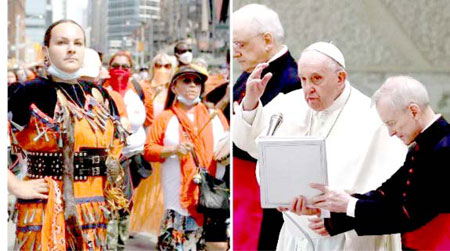Indigenous leaders from Canada and survivors of the country’s notorious residential schools met with Pope Francis on Monday and told him of the abuses they suffered at the hands of Catholic priests and school workers. They came hoping to secure a papal apology and a commitment by the church to repair the harm done.
“While the time for acknowledgement, apology and atonement is long overdue, it is never too late to do the right thing,” Cassidy Caron, president of the Metis National Council, told reporters in St. Peter’s Square after the audience.
This week’s meetings, postponed from December because of the pandemic, are part of the Canadian church and government’s efforts to respond to Indigenous demands for justice, reconciliation and reparations — long-standing demands that gained traction last year after the discovery of hundreds of unmarked graves outside some of the schools.
More than 150,000 native children in Canada were forced to attend state-funded Christian schools from the 19th century until the 1970s in an effort to isolate them from the influence of their homes and culture, and Christianize and assimilate them into mainstream society, which previous Canadian governments considered superior.
Francis set aside several hours this week to meet privately with the delegations from the Metis and Inuit on Monday, and First Nations on Thursday, with a mental health counselor in the room for each session. The delegates then gather Friday as a group for a more formal audience, with Francis delivering an address.
The encounters Monday included prayers in the Metis and Inuit languages and other gestures of deep symbolic significance. The Inuit delegation brought a traditional oil lamp, or qulliq, that is lit whenever Inuit gather and stayed lit in the pope’s library throughout the meeting. The Inuit delegates presented Francis with a sealskin stole and a sealskin rosary case.
The Metis offered Francis a pair of red beaded moccasins, “a sign of the willingness of the Metis people to forgive if there is meaningful action from the church,” the group explained. The red dye “represents that even though Pope Francis does not wear the traditional red papal shoes, he walks with the legacy of those who came before him, the good, the great and the terrible.”—AP










